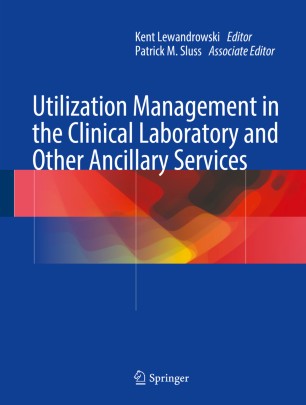Health at a Glance 2019: OECD Indicators
The european country that spends the most is Switzerland 12,2% over GDP. In Catalonia this figure was 7,6% in 2016 (less than Greece). Per capita income in 2016 was 35% more in Switzerland than in Catalonia, while health expenditure was 60% more in Switzerland. Where have the catalan taxes gone?. You know it and I know it. And everybody is aware that there is only one solution to have the appropriate public health expenditure. We have to say good bye as soon as possible.
08 de novembre 2019
07 de novembre 2019
How to identify lab tests of low effectiveness?
Prevalence and Predictability of Low-Yield Inpatient Laboratory Diagnostic Tests
A new approach to understand the size of useless lab tests is to apply: "regularized logistic regression, regress and round, naive Bayes, neural network multilayer perceptrons, decision tree, random forest, AdaBoost, and XGBoost". This means that machine learning has its own space in laboratory medicine. In the article, they show high level of prediction for useless tests.
A new approach to understand the size of useless lab tests is to apply: "regularized logistic regression, regress and round, naive Bayes, neural network multilayer perceptrons, decision tree, random forest, AdaBoost, and XGBoost". This means that machine learning has its own space in laboratory medicine. In the article, they show high level of prediction for useless tests.
The best performing machine learning models predicted normal results with an AUROC of 0.90 or greater for 12 stand-alone laboratory tests (eg, sodium AUROC, 0.92 [95%CI, 0.91-0.93]; sensitivity, 98%; specificity, 35%; PPV, 66%; NPV, 93%; lactate dehydrogenase AUROC, 0.93 [95%CI, 0.93-0.94]; sensitivity, 96%; specificity, 65%; PPV, 71%; NPV, 95%; and troponin I AUROC, 0.92 [95%CI, 0.91- 0.93]; sensitivity, 88%; specificity, 79%; PPV, 67%; NPV, 93%) and 10 common laboratory test components (eg, hemoglobin AUROC, 0.94 [95%CI, 0.92-0.95]; sensitivity, 99%; specificity, 17%; PPV, 90%; NPV, 81%; creatinine AUROC, 0.96 [95%CI, 0.96-0.97]; sensitivity, 93%; specificity, 83%; PPV, 79%; NPV, 94%; and urea nitrogen AUROC, 0.95 [95%CI, 0.94, 0.96]; sensitivity, 87%; specificity, 89%; PPV, 77%; NPV 94%).This approach goes further than this book:
03 de novembre 2019
It's always about quality
La qualité des services de santé. Un impératif mondial en vue de la couverture santé universelle
Improving healthcare quality in Europe. Characteristics, effectiveness and implementation of different strategies
Improving healthcare quality in Europe. Characteristics, effectiveness and implementation of different strategies
The essential element of access to healthcare overshadows the understanding that better health can only be achieved if accessed services are also of high quality. The Sustainable Development Goals spell this out quite clearly: “Achieve universal health coverage, including financial risk protection, access to quality essential health-care services and access to safe, effective, quality and affordable essential medicines and vaccines for all” (Goal 3, Target 8). Indeed, ensuring that healthcare services are of good quality is an imperative for policy-makers at all levels and an important contributor to health system performance.
02 de novembre 2019
Eurohealth
Everything you always wanted to know about European Union health policies but were afraid to ask
I have to say that I am not afraid to ask about health policies in EU because EU is basically a market. Therefore nothing to ask. Social policy is out of the real scope of EU.However, as a regulator of the market for health has clear examples of disfunctioning. For example, implantable medical devices regulation currently applied was enacted in 1990. New regulation will be applied next year, after 30 years of regulatory vacation. Nothing to add. Taxes haven't been on vacation. Shame on Europe. By the way, you'll not find minor details like this one in the book.
I have to say that I am not afraid to ask about health policies in EU because EU is basically a market. Therefore nothing to ask. Social policy is out of the real scope of EU.However, as a regulator of the market for health has clear examples of disfunctioning. For example, implantable medical devices regulation currently applied was enacted in 1990. New regulation will be applied next year, after 30 years of regulatory vacation. Nothing to add. Taxes haven't been on vacation. Shame on Europe. By the way, you'll not find minor details like this one in the book.
01 de novembre 2019
The impact of an ageing population (2)
Working Better With Age
WORKING AT OLDER AGES
Why it’s important, how it affects health, and the policy options to support health capacity for work
The message of OECD report:
WORKING AT OLDER AGES
Why it’s important, how it affects health, and the policy options to support health capacity for work
The message of OECD report:
The number of older inactive people who will need to be supported by each worker could rise by around 40% between 2018 and 2050 on average in the OECD area. This would put a brake on rising living standards as well as enormous pressure on younger generations who will be financing social protection systems. Improving employment prospects of older workers will be crucial. At the same time, taking a life-course approach will be necessary to avoid accumulation of individual disadvantages over work careers that discourage or prevent work at an older age; What can countries do to help? How can they give older people better work incentives and opportunities? This report provides a synthesis of the main challenges and policy recommendations together with a set of international best practices to foster employability, labour demand and incentives to work at an older age.And the WHO report message:
Dominant policy approaches such as increasing the statutory retirement age are often overshadowed by a lack of attention to two critical questions: firstly, are older workers in sufficiently good health to work longer? And secondly, does increasing the statutory retirement age have consequences, negative or positive, for the health of older workers?
29 d’octubre 2019
The impact of an ageing population
Sustainable health financing with an ageing population: implications of different revenue raising mechanisms and policy options
Sustainable health financing with an ageing population: Will population ageing lead to uncontrolled health expenditure growth?
Three documents from WHO Europe are available regarding financing health for an ageing population. You can skip the third, it is about predictions for 2060. This is useless as I've said many times.
However, I agree with this comment:
Sustainable health financing with an ageing population: Will population ageing lead to uncontrolled health expenditure growth?
Three documents from WHO Europe are available regarding financing health for an ageing population. You can skip the third, it is about predictions for 2060. This is useless as I've said many times.
However, I agree with this comment:
These analyses find that population ageing is not, and will not become, a major driver of growth in health expenditures. Moreover, they suggest that in countries where age demographics are changing but the size of the older population is not yet large, the costs of improving coverage and access to services for older people is likely to be manageable and now is a good time to begin investing in the health system while the population is relatively young.
However, while population ageing will not become a main driver of health expenditure growth, policy choices related to how health services are delivered, the prices paid (or negotiated) for services, medicines and technologies, and volumes of care will ultimately determine health spending by age trends.
25 d’octubre 2019
The end of social health insurance
Social Health Insurance in Europe: Basic Concepts and New Principles
During the first decade of this century, health reforms have advocated for universal health coverage in those countries with social health insurance based on contributions. This is a strong trend that needs to be evaluated. A recent article describes in detail these changes and says:
During the first decade of this century, health reforms have advocated for universal health coverage in those countries with social health insurance based on contributions. This is a strong trend that needs to be evaluated. A recent article describes in detail these changes and says:
Contrary to some expectations, SHI in Europe has further expanded toward universal coverage, with access to health care considered a right based on either direct or indirect financial contributions. Indeed, Germany is now the only example in Europe where groups of the population can opt out from the main insurance system. And, since 2009, the overall population is required to be covered by either social or private insurance.
Subscriure's a:
Missatges (Atom)



